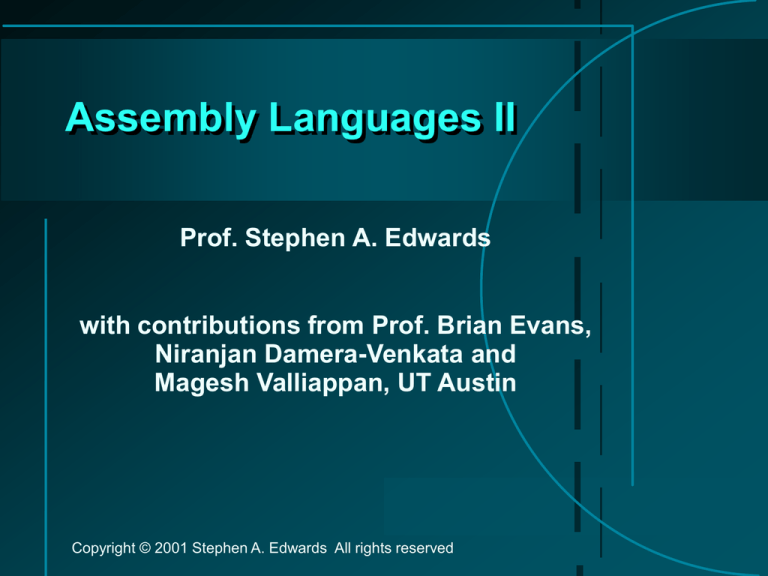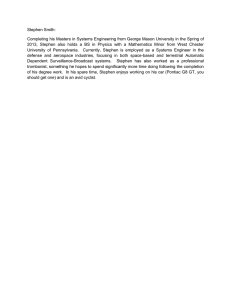
Assembly Languages II
Prof. Stephen A. Edwards
with contributions from Prof. Brian Evans,
Niranjan Damera-Venkata and
Magesh Valliappan, UT Austin
Copyright © 2001 Stephen A. Edwards All rights reserved
Last Time
General model of assembly language
• Undifferentiated sequence of instructions
• Arithmetic instructions (ADD, SUB)
• Control-flow (JMP, CALL, RET)
Four main types: CISC, RISC, DSP, and VLIW
CISC
• Few, special-purpose registers
• Complex addressing modes
• Powerful instruction (e.g., string move)
RISC
• Many general-purpose registers
• Few addressing modes
• Arithmetic operations don’t touch memory
• Simple instructions
Copyright © 2001 Stephen A. Edwards All rights reserved
Digital Signal Processor Apps.
Low-cost embedded systems
•
High-throughput applications
•
Halftoning, base stations, 3-D sonar, tomography
PC based multimedia
•
Modems, cellular telephones, disk drives, printers
Compression/decompression of audio, graphics, video
Embedded processor requirements
•
Inexpensive with small area and volume
•
Deterministic interrupt service routine latency
•
Low power: ~50 mW (TMS320C54x uses 0.36 mA/MIPS)
Copyright © 2001 Stephen A. Edwards All rights reserved
Conventional DSP Architecture
Harvard architecture
•
Separate data memory/bus and program memory/bus
•
Three reads and one or two writes per instruction cycle
Deterministic interrupt service routine latency
Multiply-accumulate in single instruction cycle
Special addressing modes supported in hardware
•
Modulo addressing for circular buffers for FIR filters
•
Bit-reversed addressing for fast Fourier transforms
Instructions to keep the pipeline (3-4 stages) full
•
Zero-overhead looping (one pipeline flush to set up)
•
Delayed branches
Copyright © 2001 Stephen A. Edwards All rights reserved
Conventional DSPs
Cost/Unit
Architecture
Registers
Data Words
Fixed-Point
Floating-Point
$5 - $79
$5 - $381
Accumulator
load-store or
memory-register
2-4 data, 8 address
16 or 24 bit
Chip Memory 2-64K data and program
8-16 data, 8-16 address
32 bit
8-64K data and program
16-128K data,
16-64K program
16M – 4Gdata,
16M – 4G program
Compilers
Bad C
Better C, C++
Examples
TI TMS320C5x;
Motorola 56000
TI TMS320C3x;
Analog Devices SHARC
Address
Space
Copyright © 2001 Stephen A. Edwards All rights reserved
Conventional DSPs
Market share: 95% fixed-point, 5% floating-point
Each processor comes in dozens of configurations
•
Data and program memory size
•
Peripherals: A/D, D/A, serial, parallel ports, timers
Drawbacks
•
No byte addressing (needed for image and video)
•
Limited on-chip memory
•
Limited addressable memory on most fixed-point DSPs
•
Non-standard C extensions to support fixed-point data
Copyright © 2001 Stephen A. Edwards All rights reserved
DSP Example
Finite Impulse Response filter (FIR)
Can be used for lowpass, highpass, bandpass, etc.
Basic DSP operation
For each sample, computes
z-1
z-1
k
yn =
a x
i
n+i
i=0
a0 … ak are filter coefficients
xn and yn are the nth input and output sample
Copyright © 2001 Stephen A. Edwards All rights reserved
z-1
56001 Programmer’s Model
55 48 47
a2
b2
24 23
0
15
x1
y1
x0
y0
Source
Registers
a1
b1
a0
b0
Accumulators
Pointer Offset Modifier
0 15
0 15
n7
n6
n5
n4
m7
m6
m5
m4
r3
r2
r1
r0
n3
n2
n1
n0
m3
m2
m1
m0
15
PC Stack
0
15
Address
Registers
Copyright © 2001 Stephen A. Edwards All rights reserved
…
r7
r6
r5
r4
0
Program counter
Status Register
Loop Address
Loop Count
…
15
0
SR Stack
0
Stack Pointer
56001 Datapath
x1
x0
y0
y1
multiplier
X bus
Y bus
shifter
a2
b2
alu
a1
b1
a0
b0
shifter/limiter
Copyright © 2001 Stephen A. Edwards All rights reserved
56001 Memory Spaces
Three memory regions, each 64K:
•
•
•
24-bit Program memory
24-bit X data memory
24-bit Y data memory
Idea: enable simultaneous access of program,
sample, and coefficient memory
Three on-chip memory spaces can be used this way
One off-chip memory pathway connected to all three
memory spaces
Only one off-chip access per cycle maximum
Copyright © 2001 Stephen A. Edwards All rights reserved
56001 Address Generation
Addresses come from pointer register r0 … r7
Offset registers n0 … n7 can be added to pointer
Modifier registers cause the address to wrap around
Zero modifier causes reverse-carry arithmetic
Address
Notation
Next value of r0
r0
(r0)
r0
r0 + n0
(r0+n0)
r0
r0
(r0)+
(r0 + 1) mod m0
r0 – 1
–(r0)
r0 – 1 mod m0
r0
(r0)–
(r0 – 1) mod m0
r0
(r0)+n0
(r0 + n0) mod m0
r0
(r0)-n0
(r0 – n0) mod m0
Copyright © 2001 Stephen A. Edwards All rights reserved
FIR Filter in 56001
n
start
samples
coefficients
input
output
equ
equ
equ
equ
equ
equ
20
$40
$0
$0
$ffe0
$ffe1
Define symbolic constants
Addresses of
memory-mapped I/O
“Locate this in program
memory at $40”
“Initialize pointers to
samples and
coefficients”
org p:start
move #samples, r0
move #coefficients, r4
move #n-1, m0
move m0, m4
“Prepare to treat these as
circular buffers of size n”
Copyright © 2001 Stephen A. Edwards All rights reserved
FIR Filter in 56001
movep
y:input, x:(r0)
“Clear accumulator A”
clr
“Load a sample from an I/O
device in Y data memory”
“Load a sample from X memory
into x0, advance the pointer”
a
x:(r0)+, x0
y:(r4)+, y0
“Load a coefficient from Y memory
into y0, advance the pointer”
rep
mac
#n-1
x0,y0,a
x:(r0)+, x0
macr
x0,y0,a
(r0)-
movep
a, y:output
Copyright © 2001 Stephen A. Edwards All rights reserved
y:(r4)+, y0
FIR Filter in 56001
movep
y:input, x:(r0)
clr
a
x:(r0)+, x0
y:(r4)+, y0
“Repeat the next instruction n-1 times”
rep
mac
#n-1
x0,y0,a
“Fetch next sample and coefficient”
macr
x0,y0,a
movep
a, y:output
x:(r0)+, x0
(r0)-
Copyright © 2001 Stephen A. Edwards All rights reserved
y:(r4)+, y0
“a = a + x0 * y0”
FIR Filter in 56001
movep
y:input, x:(r0)
clr
a
x:(r0)+, x0
y:(r4)+, y0
rep
mac
#n-1
x0,y0,a
x:(r0)+, x0
y:(r4)+, y0
macr
x0,y0,a
(r0)-
movep
a, y:output
“Get ready for the
next sample”
“a = a + x0 * y0 and
round the result”
“Write the filtered result to an I/O
device in Y data memory”
Copyright © 2001 Stephen A. Edwards All rights reserved
TI TMS320C6000 VLIW DSP
Eight instruction units dispatched by one very long
instruction word
Designed for DSP applications
Orthogonal instruction set
Big, uniform register file (16 32-bit registers)
Better compiler target than 56001
Deeply pipelined (up to 15 levels)
Complicated, but more regular, datapath
Copyright © 2001 Stephen A. Edwards All rights reserved
Pipelining on the C6
One instruction issued per clock cycle
Very deep pipeline
•
•
•
4 fetch cycles
2 decode cycles
1-10 execute cycles
Branch in pipeline disables interrupts
Conditional instructions avoid branch-induced stalls
No hardware to protect against hazards
•
Assembler or compiler’s responsibility
Copyright © 2001 Stephen A. Edwards All rights reserved
’C6 Datapath
A0
…
…
.L1
B0
A15
B15
.S1 .M1
.D1
D
A
.D2
A
Copyright © 2001 Stephen A. Edwards All rights reserved
.M2 .S2
D
.L2
’C6 Datapath
Two identical halves
B0
…
Each has
•
•
•
•
•
16 32-bit registers
Logical/Arithmetic (.L)
Shifter/Branching (.S)
Multiplier (.M)
Data/Memory (.D)
B15
.D2
.M2 .S2
One cross path
A
Copyright © 2001 Stephen A. Edwards All rights reserved
D
.L2
FIR in ’C6 Assembly
“Load a halfword (16 bits)”
FIRLOOP:
LDH
||
LDH
|| [B0] SUB
|| [B0] B
||
MPY
||
ADD
“Do this on unit D1”
.D1
.D2
.L2
.S2
.M1X
.L1
*A1++, A2
*B1++, B2
B0, 1, B0
FIRLOOP
A2, B2, A3
A4, A3, A4
; Fetch next sample
; Fetch next coefficient
; Decrement loop count
; Branch if non-zero
; Sample * Coefficient
; Accumulate result
X: “Use the cross path”
predicated instruction:
“Execute only if B0 is non-zero”
“Run all of these
instructions in parallel”
Copyright © 2001 Stephen A. Edwards All rights reserved
Peripherals
Often the whole point of the system
Memory-mapped I/O
•
Magical memory locations that make something
happen or change on their own
Typical meanings:
•
•
•
Configuration (write)
Status (read)
Address/Data (access more peripheral state)
Copyright © 2001 Stephen A. Edwards All rights reserved
Example: 56001 Port C
Nine pins each usable in one of two ways
• Simple parallel I/O
• Serial interface
Parallel
PC0
PC1
PC2
Serial
RxD
TxD
SCLK
Serial Communication Interface (SCI)
PC3
PC4
PC5
PC6
PC7
PC8
SC0
SC1
SC2
SCK
SRD
STD
Synchronous Serial Interface (SSI)
Copyright © 2001 Stephen A. Edwards All rights reserved
Port C Registers for Parallel Port
Port C Control Register
•
Selects mode (parallel or serial) of each pin
X: $FFE1
0 = parallel I/O
1 = serial I/O
Port C Data Direction Register
•
I/O direction when used in parallel mode
X: $FFE3
0 = Input
1 = Output
Copyright © 2001 Stephen A. Edwards All rights reserved
Port C Registers for Parallel Port
Port C Data Register
•
Returns input data or sets output state of parallel port
X: $FFE5
Read: pin state
Write: set output pin state
Copyright © 2001 Stephen A. Edwards All rights reserved
Port C SCI
Three-pin interface
422 Kbit/s NRZ asynchronous interface (RS-232-like)
3.375 Mbit/s synchronous serial mode
Multidrop mode for multiprocessor systems
Two Wakeup modes
•
•
Idle line
Address bit
Wired-OR mode
On-chip or external baud rate generator
Four interrupt priority levels
Copyright © 2001 Stephen A. Edwards All rights reserved
Port C SCI Registers
X: $FFF0
SCI Control
Register
Copyright © 2001 Stephen A. Edwards All rights reserved
Word select bits
Shift direction
Send break
Wakeup mode select
Receiver wakeup enable
Wired-OR mode select
Receiver Enable
Transmitter Enable
Idle line interrupt enable
Receive interrupt enable
Transmit interrupt enable
Timer interrupt enable
Clock polarity
Port C SCI Registers
X: $FFF1
SCI Status
Register (readonly)
Copyright © 2001 Stephen A. Edwards All rights reserved
Transmitter Empty
Transmitter Reg Empty
Receive Data Full
Idle Line
Overrun Error
Parity Error
Framing Error
Received bit 8
Port C SCI Registers
X: $FFF2
SCI Clock
Control Register
Copyright © 2001 Stephen A. Edwards All rights reserved
Clock Divider Bits
Clock Output Divider
Clock Prescaler
Receive Clock Source
Transmit Clock Source
Port C SSI
Intended for synchronous, constant-rate protocols
•
Easy interface to serial ADCs and DACs
Many more operating modes than SCI
Six Pins (Rx, Tx, Clk, Rx Clk, Frame Sync, Tx Clk)
8, 12, 16, or 24-bit words
Copyright © 2001 Stephen A. Edwards All rights reserved
Port C SSI Registers
$FFEC SSI Control Register A
•
prescaler, frame rate, word length
$FFED SSI Control Register B
•
Interrupt enables, various mode settings
$FFEE SSI Status/Time Slot Register
•
Sync, empty, overrun
$FFEF SSI Receive/Transmit Data Register
Copyright © 2001 Stephen A. Edwards All rights reserved


